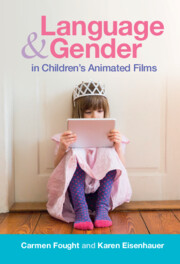Book contents
- Language and Gender in Children’s Animated Films
- Language and Gender in Children’s Animated Films
- Copyright page
- Dedication
- Contents
- Figures
- Tables
- Preface
- Acknowledgments
- 1 Introduction
- 2 Gender, Disney, and Pixar in Historical Context
- 3 Representation, Speech Amounts, and Talkativeness
- 4 Compliments
- 5 Directives
- 6 Insults
- 7 Apologies
- 8 Representing Queerness
- 9 Conclusion
- References and Filmography
- Index
8 - Representing Queerness
Published online by Cambridge University Press: 01 September 2022
- Language and Gender in Children’s Animated Films
- Language and Gender in Children’s Animated Films
- Copyright page
- Dedication
- Contents
- Figures
- Tables
- Preface
- Acknowledgments
- 1 Introduction
- 2 Gender, Disney, and Pixar in Historical Context
- 3 Representation, Speech Amounts, and Talkativeness
- 4 Compliments
- 5 Directives
- 6 Insults
- 7 Apologies
- 8 Representing Queerness
- 9 Conclusion
- References and Filmography
- Index
Summary
This chapter focuses on the discussion of queerness in Disney. Despite the overwhelming propagation of a heteronormative ideal in these films, queerness does exist, at a variety of levels. This chapter qualitatively examines the different ways that queerness is coded linguistically in Disney. This chapter identifies a source of queerness in Disney in many of its queer coded villians (quillians), linked by five key linguistic elements in their speech: playing with register or style, sarcasm and other humorous verbal aggression, wordplay or metalinguistic focus, invocation of femininity (pragmatic), and invocation of femininity (syntactic or lexical). The observed style bears a resemblance to styles documented among cis gay men and drag queens. The implications of the use of ‘Quillian Language Style’ to characterize both male and female quillains is explored, and broader implications are discussed.
- Type
- Chapter
- Information
- Language and Gender in Children's Animated FilmsExploring Disney and Pixar, pp. 173 - 203Publisher: Cambridge University PressPrint publication year: 2022

